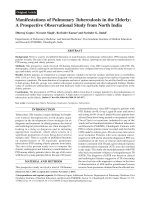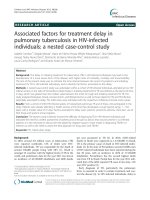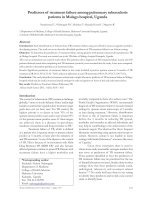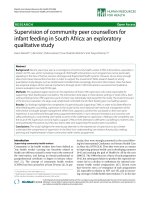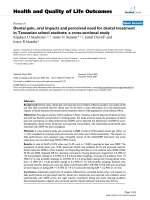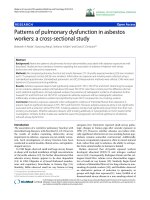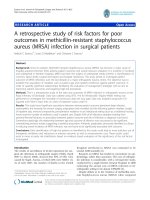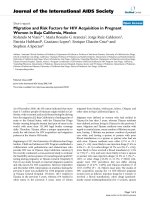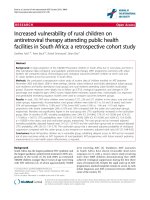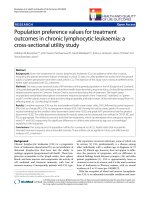Associated factors for treatment delay in pulmonary tuberculosis in HIV-infected individuals: a nested case-control study docx
Bạn đang xem bản rút gọn của tài liệu. Xem và tải ngay bản đầy đủ của tài liệu tại đây (358.07 KB, 11 trang )
RES E AR C H A R T I C L E Open Access
Associated factors for treatment delay in
pulmonary tuberculosis in HIV-infected
individuals: a nested case-control study
Isabella Coimbra
1*
, Magda Maruza
1
, Maria de Fátima Pessoa Militão-Albuquerque
2
, Líbia Vilela Moura
1
,
George Tadeu Nunes Diniz
2
, Demócrito de Barros Miranda-Filho
3
, Heloísa Ramos Lacerda
1
,
Laura Cunha Rodrigues
4
and Ricardo Arraes de Alencar Ximenes
1
Abstract
Background: The delay in initiating treatment for tuberculosis (TB) in HIV-infected individuals may lead to the
development of a more severe form of the disease, with higher rates of morbidity, mortality and transmissibility.
The aim of the present study was to estimate the time interval between the onset of symptoms and initiating
treatment for TB in HIV-infected individuals, and to identify the factors associated to this delay.
Methods: A nested case-control study was undertaken within a cohort of HIV-infected individuals, attended at two HIV
referral centers, in the state of Pernambuco, Brazil. Delay in initiating treatment for TB was defined as the period of time,
in days, which was greater than the median value between the onset of cough and initiating treatment for TB. The
study analyzed biological, clinical, socioeconomic, and lifestyle factors as well as those related to HIV and TB infection,
potentially associated to delay. The odds ratios were estimated with the respective confidence intervals and p-values.
Results: From a cohort of 2365 HIV-infected adults, 274 presented pulmonary TB and of these, 242 participated in the
study. Patients were already attending 2 health services at the time they developed a cough (period range: 1 – 552
days), with a median value of 41 days. Factors associated to delay were: systemic symptoms asthenia, chest pain, use of
illicit drugs and sputum smear-negative.
Conclusion: The present study indirectly showed the difficulty of diagnosing TB in HIV-infected individuals and
indicated the need for a better assessment of asthenia and chest pain as factors that may be present in co-infected
patients. It is also necessary to discuss the role played by negative sputum smear results in diagnosing TB/HIV co-
infection as well as the need to assess the best approach for drug users with TB/HIV.
Keywords: HIV, Tuberculosis, Delay
Background
In 2010, around 8.8 million cases of tuberculosis (TB)
were reported worldwide, 13% of which were HIV-
infected individuals. TB was responsible for the death of
around 350,000 people living with HIV [1]. Brazil is
amongst 22 countries with the highest levels of TB in the
world, and preliminary data for the year 2011 has shown
an incidence of 43/100,000 inhabitants and 4600 deaths
per year associated to TB [2]. In 2010, AIDS-related
deaths in Brazil were registered as 1.5/100,000. In Brazil,
TB is the primary cause of death in HIV-infected indivi-
duals [2]. In the state of Pernambuco around 18,000 cases
of HIV-infected individuals have been reported during the
last 30 years, with an incidence in 2010 of 17/100,000
inhabitants. Pernambuco has the second highest death
rate from TB in Brazil. Partial data for the year 2011 indi-
cated that of the 4694 reported TB cases in the state, 11%
were HIV positive [3].
Early diagnosis of TB, particularly the pulmon ary
form, is essential in order to initiate treatment and con -
trol the disease [4]. In HIV-infected indiv iduals, delay in
* Correspondence:
1
Post-graduation program in Tropical Medicine, Universidade Federal de
Pernambuco, Rua Antonio Rabelo 245, Madalena, Recife, PE CEP 50610-110,
Brazil
Full list of author information is available at the end of the article
© 2012 Coimbra et al.; licensee BioMed Central Ltd. This is an Open Access article distributed under the terms of the Creative
Commons Attribution License ( which permits unrestricted use, distribution, and
reproduction in any medium, provided the original work is properly cited.
Coimbra et al. BMC Infectious Diseases 2012, 12:208
/>initiating treatment for TB is an important factor for
high morbidity [5], mortality [1] and transmissibility of
the disease [6,7], and may also result in the prolonged
occupation of hospital beds, both in developing coun-
tries and in industrialized countries [8]. It should also be
noted that in TB/HIV co-infection, the interaction be-
tween Mycobacterium tuberculosis and HIV results in
more rapid progression of both TB and HIV [9]. One
further problem is that a high degree of immu nodefi-
ciency may modify the clinical and radiological features
of TB [10], thus making diagnosis even more difficult
and may lead to death before TB treatment has been
initiated [11].
Several studies have addressed the problem of delayed
diagnosis and treatment for TB, but only a few with
HIV-infected individuals [5,8,12-19]. Of these reports,
only the studies by Kramer [8] and Hudson [12] were
conducted exclusively with HIV-infected individuals.
Systematic reviews on the subject [20-22] have high-
lighted the lack of uniformity regarding the definition of
delay (especially when related to health services), the
characteristics of the populations studied, the sites where
studies are conducted and the prevalence of TB and
HIV. It may also be observed that HIV infection vari-
ables as potential predictors of delay have only been
included in a small number of the selected studies [22].
The aim of the present study was to assess the time
interval between the onset of symptoms and the initi-
ation of treatment for pulmonary TB in patient s living
with HIV, in referral centers for the treatment of HIV,
and to identify the factors associated with this delay.
Methods
Study design and population
A nested case-control study was undertaken within a
cohort of HIV-infected individuals , aged 18 years and
over, who had initiated treatment for pulmonary TB at
two referral centers for HIV/AIDS in the state of Per-
nambuco, Brazil, during the period from July 2007 to
February 2010 at one health center, and from October
2007 to June 2010 in a nother. A round 70% of all HIV-
infected individuals in t he state of Pernambuco attend
these two centers , which provide both outpatient a nd
inpatient care.
Exclusion criteria: (1) patients with no information on
the date of onset of cough or no cough; (2) patients who
had initiated treatment in another health service; (3)
patients for whom TB treatment had been initiated by
an attending physician by clinical suspicion, but whose
diagnosis had changed during a follow-up period of at
least 30 days (after initiating TB treatment), the length
of time necessary to observe whether there has been an
improvement in the clinical and radiological findings or
(4) patients with no laboratory confirmation (smear and
culture negative sputum) who were discharged or who
defaulted within a period shorter than 30 days after initi-
ating TB treatment. This was a strategy to minimize
misclassification (patients mistakenly classified as TB
cases) (Figure 1).
Patient recruitment
Patients attending each service were invited to partici-
pate in the study. Those who agreed were interviewed
by previously trained health professionals, using standar-
dized questionnaires, after patients had signed the
informed consent forms. Additional information was
obtained from medical records.
Definition of terms and variables
Cases of active pulmonary TB were those for whom TB
treatment had been initiated by an attending physician
through laboratory confirmation by sputum smear and/or
Figure 1 Algorithm for selection of patients for the study of factors associated with delay in initition of treatment for pulmonary
tuberculosis in HIV-infected individuals.
Coimbra et al. BMC Infectious Diseases 2012, 12:208 Page 2 of 11
/>sputum culture or clinical suspicion. Cases of disseminated
TB with lung involvement, and those with extra-
pulmonary TB associated to pulmonary TB, were also
defined as pulmonary TB.
There were no studies that could provide a uniform
definition of delayed treatment within this group of
patients. Thus, to decide the best cut-off point we firstly
used the Kaplan-Meier estimator to calculate the prob-
ability of starting tuberculosis treatment (Figure 2). Sub-
sequently, the following cut-off points were tested: the
median (41 days), 30, 60 and 86 days (values in the third
quartile of the distribution curve). Use of drugs was the
only variable, which remained in all multivariate models
(data not shown). We assumed the median as the cut-off
point and delayed TB treatment was defined as the
period of time, in days, which exceeded the median
value between the onset of cough and the initiation of
TB treatment. In the present study, the evaluated delay
was considered as a delay related to health services,
since all patients were being monitored by these services
before the onset of cough.
A study case was defined as a patient who presented a
delay in initiating treatment and a control as a patient
who did not present a delay in initiating treatment.
For purposes of the analysis, independent variables were
grouped into six blocks: biological variables (sex, age (<30;
30-49; ≥50 (years)); clinical variables (fever, weight loss,
sweating, asthenia, sputum production, hemoptysis, chest
pain, body mass index [BMI]), socioeconomic variables
(town of residence, marital status, social support/living
with whom, education, employment); variables related to
habits and lifestyle (smoking, drinking and illicit drug
use); variables related to HIV (opportunistic disease,
AIDS, CD4 T-cell count (the CD4 count was measured
over a period of less than 4 months, before the start of
treatment and was cate gorized with the intervals: ≤ 50,
51 – 200, 201 – 500, > 500 (cells/mm3)), use of antiretro-
viral therapy); variables related to TB (initiation of treat-
ment in outpatients or hospital, radiological pattern, past
history of TB, contact with person undergoing treatment
for TB, sputum smear or sputum culture.
With regard to the variable of alcohol consumption,
individuals were considered drinkers if they: drink half a
portion of beer (400ml), a glass of wine (250 ml) or spir-
its (60 ml). Abstainers were considered those who either
never drink or drink less than eight units a year, light
drinkers as those who drink on no more than two days a
week (without exceeding ten units per month), heavy
drinkers as those who drink in excess of five units per
day at least 3 to 4 times a week, and alcohol dependent
if they were undergoing treatment for alcoholism. For
analysis, individuals were placed into three categories:
abstainer/light drinker (has never drunk or drinks two
days a week, but less than 10 drinks/mo nth), moderate/
Figure 2 Kaplan-Meier curve for the start of tuberculosis treatment after the onset of symptoms in a cohort of HIV-infected
individuals.
Coimbra et al. BMC Infectious Diseases 2012, 12:208 Page 3 of 11
/>heavy drinker (drinks 3 to 4 days a week with more than
5 drinks/day, and those undergoing treatment for
alcoholism).
With regard to smoking, individuals were categorized
as: non-smokers (those who have never smoked); ex-
smokers (those who stopped smoking at least six months
prior to the study) and smokers (those who smoked at
inclusion of the study or had stopped smoking for less
than six months).
The criteria used to define AIDS were those adopted
by the Ministry of Health in Brazil [23].
The variable use of drugs was analyzed in two man-
ners: one, with an independent evaluation of each drug,
and the other considering the use of at least one drug
(marijuana, cocaine, crack and glue). For the multivariate
analysis the variable use of drugs was employed.
The presence of 1, 2 or 3 constitutional symptoms of
fever, weight loss or asthenia was assessed as a com-
pound variable, which for purposes of analysis are re-
ferred to as systemic symptoms.
Antiretroviral therapy (ART) was defined as a combin-
ation of three different antiretroviral drugs, regardless of
the number of drug classes used.
Statistical analysis
The mean and median time interval between the onset
of cough and the initiation of treatment for TB were cal-
culated, in days. The magnitude of the association of
each variabl e of the study with treatment delay was mea-
sured by odds ratio (OR) and the statistical significance
was tested by the confidence interval (CI) and p value
(Chi-square test or maximum likelihood ratio) . The sig-
nificance level was set at P < 0.05.
Since the time elapsed between the onset of symptoms
and the first consultation could influence the delay time,
the period of time between the onset of symptoms and
the first consultation was compared according to the dif-
ferent categories of each variable that remained in the
final model, using the Mann–Whitney or Kruskal-Wallis
tests.
Double data entry was performed, which were then
compared, validated and subsequently corrected. Data
entry was performed concurrently with data collection,
and the database was managed by SQL 2000 (Microsoft),
using GeneXus 7.5. Data were analyzed using the R ver-
sion 2.10.0.
A multivariate logistic regression model was used in two
stages. In the first, a multivariate regression analysis was
undertaken in each group, starting with a minimal model
and adding one variable at a time. Variables associated to
treatment delay where P < 0.20 in the univariate analysis
were subsequently included in the intragroup logistic re-
gression model, and those associated with a P value ≤ 0.05
remained in the model. In a second stage, for the final
multivariate model: variables selected in the previous stage
were introduced into the final multivariate model (includ-
ing variables from all groups) and those with a P value ≤
0.05 remained in the final model.
This study is part of the CSV Project 182/06 - Project
for clinical and epidemiological study of TB/HIV co-
infection in Recife, approved by the Ethics Committee of
the Universidade Federal de Pernambuco (registration
SISNEP FR-067 159/CAAE 0004.1.172.106-05 / register
CEP / CCS / UFPE 254/05).
Results
From a cohort of 2365 HIV-infected individuals, 629
initiated treatment for TB during the period of study. Of
these, 274 had the pulmonary form of the disease and
constituted the study population. Of these, 32 were
excluded according to the algorithm of Figure 1. Two
hundred and forty-two patients participated in this
study. The age-range of the study population was 18 -67
years, with an average of 38.2 years (SD = 10.09 years),
and 69.4% of patients were male.
The time interval between the onset of cough and the
initiation of treatment for TB ranged from a minimum
of 1 day to a maximum of 552 days, with a median of 41
days (19-85 days, interquartile range). The mean CD4-
cell count was 213.9 cells/mm
3
and a median of 142
cells/ mm
3
with a range of 1 to 1,254 cells/mm3, and
57.8% were taking ART at the initiation of treatment for
TB. A total of 110 patients (45.4%) were living with
AIDS, and 30.9% reported using some form of illicit
drug. Sputum smear was negative in 40.9% and was not
performed by 23.9%. Sputum culture was not performed
in 65.1% of the patients, and was positive for 11.8%. No
information was available concerning sputum smear and
culture for 0.7% and 19,4% respectively, of the study
population. It is probable that these patients did not per-
form these tests.
The results of the univariate analysis of the factors asso-
ciated to a delay in initiating treatment for TB in HIV-
infected individuals are presented in Table 1. The variables
that indicated a statistically significant association with
delay, in the univariate model were: - clinical variables:
weight loss, asthenia, sweating and chest pain; - variables
related to habits and lifestyle: use of marijuana, cocaine
and crack; - variables related to TB: sputum smear-
negative; - variable composed of systemic symptoms: pres-
ence of two or three constitutional symptoms (fever and/
or weight loss and/or asthenia).
Two multivariate models were run, one introducing
the variable asthenia and, the other, introducing the vari-
able systemic symptoms. No statistically significant dif-
ference was observed between the two models (p = 1).
Variables that remained in the first final model were: as-
thenia (OR: 1.93, 95%-CI: 1.05-3.59), chest pain (OR:
Coimbra et al. BMC Infectious Diseases 2012, 12:208 Page 4 of 11
/>Table 1 Univariate analysis of the factors associated with a delay (defined according to the median value (cutoff)) in
initiating treatment for tuberculosis in HIV-infected individuals
Variable Delayed (> 41 days) No delay ( ≤ 41 days) OR 95%- CI p-value
n(120) % n(122) %
BIOLOGICAL
Sex (n = 242)
Female 35 29.17 39 31.97 1.00
Male 85 70.83 83 68.03 1.14 0.66-1.98 0.6365
Age (n = 242)
< 30 years 24 20.00 24 19.67 1.00
30 – 49 years 80 66.67 79 64.75 1.01 0.53-1.94 0.9695
≥ 50 years 16 13.33 19 15.57 0.84 0.35-2.02 0.6997
SOCIOECONOMIC
Town of residence (n = 239)
Countryside 20 16.81 19 15.83 1.00
Capital/metropolitan region 99 83.19 101 84.17 0.93 0.47-1.85 0.8387
Marital status (n = 241)
Married 26 21.67 25 20.66 1.00
Single/separated/widowed 94 78.33 96 79.34 0.94 0.51-1.75 0.8485
Living with (n = 228)
Family/partner 92 81.42 97 84.35 1.00
Alone 21 18.58 18 15.65 1.23 0.62-2.48 0.5571
Education (n = 241)
Up to 9 years of school 67 56.30 77 63.11 1.00
9 or more years of school 52 43.70 45 36.89 1.33 0.79-2.23 0.2814
In employment (n = 241)
No 83 69.75 83 68.03 1.00
Yes 36 30.25 39 31.97 0.92 0.53-1.59 0.7737
Lifestyle
Drinking (n = 208)
Abstainer/light drinker 91 91.00 100 92.59 1.00
Moderate/heavy 9 9.00 8 7.41 1.24 0.45-3.42 0.6757
Smoking (n = 241)
Never smoked 44 36.97 51 41.80 1.00
Ex-smoker 49 41.18 51 41.80 1.11 0.63-1.96 0.7076
Smoker 26 21.85 20 16.39 1.51 0.74-3.09 0.2569
Use of illicit drugs (n = 239)
No 70 59.32 94 77.69 1.00
Yes 48 40.68 27 22.31 2.39 1.37-4.24 0.0025
Use of marijuana (n = 239)
Yes 47 39.83 27 22.31 1.00
No 71 60.17 94 77.69 0.43 0.24-0.76 0.0038
Use of cocaine (n = 239)
Yes 19 16.10 9 7.44 1.00
No 99 83.90 112 92.56 0.42 0.17-0.94 0.0417
Use of crack (n = 239)
Coimbra et al. BMC Infectious Diseases 2012, 12:208 Page 5 of 11
/>Table 1 Univariate analysis of the factors associated with a delay (defined according to the median value (cutoff)) in
initiating treatment for tuberculosis in HIV-infected individuals (Continued)
Yes 23 19.49 7 5.79 1.00
No 95 80.51 114 94.21 0.25 0.10-0.59 0.0025
Use of shoemaker glue (n = 239)
Yes 11 9.32 11 9.09 1.00
No 107 90.68 110 90.91 0.97 0.40-2.36 0.9507
Variables (Delayed) > 41 days (No delay) ≤ 41 days OR 95%- CI p-value
n% n %
HIV Variables
Opportunistic disease (n = 238)
Yes 73 72.12 72 71.96 1.00
No 45 27.88 48 28.04 0.92 0.55-1.56 0.7682
AIDS (n = 238)
Yes 53 44.92 57 47.50 1.00
No 65 55.08 63 52.50 1.11 0.67-1.85 0.6893
CD4 Count (n = 175)
≤ 50 cels/mm
3
27 32.14 23 25.27 1.00
51 – 200 cels/mm
3
25 29.76 35 38.46 0.61 0.28-1.29 0.1982
201 – 500 cels/mm
3
22 26.19 24 26.37 0.78 0.35-1.74 0.5458
>500 cels/mm
3
10 11.90 9 9.89 0.95 0.33-2.77 0.9189
Use of ART (n= 240)
Yes 67 55.83 73 60.83 1.00
No 53 44.17 47 39.17 1.23 0.74-2.06 0.4323
TB VARIABLES
Place where initiated TB treatment (n = 180)
Outpatients 42 46.67 42 46.67 1.00
Inpatients 48 53.33 48 53.33 1.00 0.56-1.80 1.0000
Standard chest x-ray (n = 220)
Atypical 92 85.19 92 82.14 1.00
Normal 1 0.93 3 2.68 0.33 0.02-2.66 0.3453
Typical 15 13.89 17 15.18 0.88 0.41-1.87 0.7443
Contact with person undergoing TT TB (n = 239)
Yes 81 68.64 84 69.42 1.00
No 37 31.36 37 30.58 1.04 0.60-1.80 0.8966
TB contact in the household (n = 75)
Yes 15 40.54 10 26.32 1.00
No 22 59.46 28 73.68 0.52 0.19-1.38 0.1940
Previous treatment (n = 236)
Yes 29 24.58 31 26.27 1.00
No 89 75.42 87 73.73 1.09 0.61-1.97 0.7650
Sputum smear (n = 225)
Positive 29 26.13 39 34.21 1.00
Negative 58 52.25 41 35.96 1.90 1.02-3.58 0.0438
Not performed 24 21.62 34 29.82 0.95 0.47-1.93 0.8858
Sputum Culture (n = 195)
Coimbra et al. BMC Infectious Diseases 2012, 12:208 Page 6 of 11
/>2.16, 95%-CI: 1.10-4.19), use of illicit drugs (OR: 2.79,
95%-CI: 1.47-5.43), sputum smear-negative (OR: 2.22,
95%-CI: 1.10-4.54). Variables in the second model are
presented in Table 2.
There was no difference in time between the onset of
cough and a new consultation according to the categor-
ies of the variables that remained in the final multivari-
ate model (Table 3).
Table 1 Univariate analysis of the factors associated with a delay (defined according to the median value (cutoff)) in
initiating treatment for tuberculosis in HIV-infected individuals (Continued)
Positive 14 15.05 9 8.82 1.00
Negative 27 29.03 18 17.65 0.96 0.34-2.68 0.9447
Not performed 52 55.91 75 73.53 0.45 0.17-1.09 0.0815
Weight loss (n = 221)
No 30 26.55 47 43.52 1.00
Yes 83 73.45 61 56.48 2.13 1.22-3.78 0.0086
Anemia (n = 169)
No 17 19.77 19 22.89 1.00
Yes 69 80.23 64 77.11 1.20 0.58-2.54 0.6202
Asthenia (n = 241)
No 40 33.33 64 52.89 1.00
Yes 80 66.67 57 47.11 2.25 1.34-3.80 0.0023
Sweating (n = 233)
No 56 47.46 70 60.87 1.00
Yes 62 52.54 45 39.13 1.72 1.03-2.90 0.0406
Variables Delayed > 41 days No delay ≤ 41 days OR 95%- CI p-value
n% n %
Production of Sputum (n = 242)
Yes 74 61.67 77 63.11 1.00
No 46 38.33 45 36.89 1.06 0.63-1.79 0.8161
Dyspnea (n = 213)
No 68 63.55 77 72.64 1.00
Yes 39 36.45 29 27.36 1.52 0.85-2.74 0.1558
BMI (n = 211)
≥ 18.5 75 72.12 77 71.96 1.00
< 18.5 29 27.88 30 28.04 0.99 0.54-1.81 0.9803
Hemoptysis (n= 230)
No 104 88.89 102 90.27 1.00
Yes 13 11.11 11 9.73 1.16 0.50-2.75 0.7330
Chest Pain (n = 222)
No 70 61.40 81 75.00 1.00
Yes 44 38.60 27 25.00 1.89 1.07-3.38 0.0309
Constitutional Symptoms (n = 242)
None 13 10.83 26 21.31 1.00 -
1* 23 19.17 37 30.33 1.24 0.54-2.94 0.6136
2** 40 33.33 36 29.51 2.22 1.01-5.07 0.0515
3*** 44 36.67 23 18.85 3.83 1.69-9.04 0.0016
OR = Odds Ratio CI = Confidence Interval ART = Antiretroviral Therapy TB = Tuberculosis.
TT TB = TB treatment.
1* asthenia or weight loss or fever.
2* (asthenia and weight loss) or (asthenia and fever) or (weight loss and fever).
3* asthenia and weight loss and fever.
Coimbra et al. BMC Infectious Diseases 2012, 12:208 Page 7 of 11
/>Discussion
In the present study, a median of 41 days was encoun-
tered between the onset of cough and the initiation of
treatment for pulmonary TB in HIV-infected individuals.
When this time interval was greater than the median it
was assumed that a delay in initiating treatment had
taken place and that it was related to the health service.
Comparison of our results with those of others is not
straightforward. There is no optimal cut-off point to de-
fine delay and the characteristics of the studied popula-
tions differ. Our figure (41 days) was higher than those
found in studies conducted in a number of countries
throughout Asia and Sub-Saharan Africa (ranging from
13-38 days) [8,14,16,17,24-28], where the median was
also the criterion to define health service associated
treatment delay, however it was lower than those
obtained in Gambia [29]. In a systematic review, the
mean delay related to health services in countries with
low to moderate financial resources was 28.4 days [21].
There is no basis to judge which of these periods would
be acceptable, since a few [17,27,29] of the studies evalu-
ated the consequences of the delay on the outcome of
TB treatment.
Differences in the population composition regarding
the frequency of HIV-infected individuals is also one im-
portant factor that may affect comparability between
studies. Finnie et al [22] reported that HIV and its rela-
tion with a delay in diagnosing and treating TB was
assessed in only 20% of the studies selected for their
systematic review. The frequency of HIV-infected indivi-
duals in several studies ranged from 16.4% to 67%
[14-17], some of which were conducted in countries
with a high prevalence of TB/HIV co-infection. Since
different criteria were used to define treatment delay it
was not possible to compare our findings with those of
Kramer [12] and Hudson [8], who also focused their
studies on HIV-infected patients.
Patients who participated in the present study had
regular scheduled consultations before initiating treat-
ment for TB at the two health centers, which are referral
centers for treating HIV-infected individuals. It is pos-
sible that the differences found in relation to other stud-
ies conducted in places with a similar prevalence of TB/
HIV co-infection are related to features of the health ser-
vices and the definition for treatment delay.
The independent factors associated with a delay in
the initiation of treatment were: the use of illicit
drugs, chest pain, sputum smear-negative and the
presence of at lea st two constitutional symptoms:
fever, asthenia and weight loss. There is evidence that
intravenous drug users living with HIV, tend to develop
TB more than those living with HIV who are not drug
users [30,31]. Nevertheless, drug use has been described
as a factor associated with the delayed diagnosis of TB
[32]. One explanation for this would be the suppression of
the cough reflex as well as the patient’slackofawareness
regarding the cough [31]. This same author suggests that
Table 2 Results of the final multivariate model* of factors
associated to a delay in initiating treatment for
tuberculosis, including systemic symptoms in HIV-infected
individuals
Variables OR
adj
95%- CI p-value
Systemic Symptoms
None 1.00 -
1 symptom** 1.25 0.50 – 3.22 0.6330
2 symptoms*** 1.56 0.63 – 3.94 0.3345
3 symptoms**** 2.41 0.95 – 6.29 0.0679
Use of Drugs
No 1.00 -
Yes 2.56 1.35 – 4.95 0.0044
Chest Pain
No 1.00 -
Yes 2.14 1.13 – 4.16 0.0214
Sputum smear
Positive 1.00 -
Negative 2.23 1.11 – 4.57 0.0264
Not performed 1.28 0.57 - 2.87 0.5502
OR = Odds Ratio CI = Confidence Interval.
*Model run with 204 observations.
** asthenia or weight loss or fever, *** (asthenia and weight loss) or (asthenia
and fever) or (weight loss and fever),.
**** asthenia and weight loss and fever.
Table 3 Time to a new consultation after the onset of
cough according to the variables that remained in the
multivariate model
Cough 1
st
consultation (days) N Median Mean SD p-value
Systemic Symptoms
None 32 30 43,59 7,53 0,8264*
1* symptom 50 41 63,78 11,90
2* symptoms 70 36 52,01 6,11
3* symptoms 60 38 65,7 10,30
Use of Illicit Drugs
Yes 70 35 63,01 9,98 0,6670**
No 139 31 54,5 5,02
Chest Pain
Yes 64 57 60,88 6,97 0,2620**
No 128 34 56,19 6,31
Sputum smear
Positive 62 34 59,4 10,34 0,9822*
Negative 91 34 56,18 6,50
Not performed 44 30 53,64 8,99
* Kruskal-Wallis test.
** Mann–Whitney.
Coimbra et al. BMC Infectious Diseases 2012, 12:208 Page 8 of 11
/>the fear of stigma and the emergence of withdrawal symp-
toms as the patient comes off the drugs, plus the belief
held by health professionals that drug users have poor ad-
herence to long-term treatment, are factors that contrib-
ute to a delay in diagnosing TB [31]. It is the belief of this
study that the introduction of educational programs for
health teams would help to facilitate dialogue with these
patients, and that close monitoring would contribute to
reducing this delay.
Chest pain is one of the symptoms associated with TB
in some studies [18,19,33], but no studies have been
encountered with an association of diagnostic and treat-
ment delay of TB related to health services. Ngadaya et
al [19] identified that chest pain was associated with the
delayed diagnosis of TB, in relation to the patient, since
he/she does not attribute sufficient attention to the pain
as being a symptom of TB. Chest pain can be attributed
to several causes, such as diseases of the pleura, cardio-
vascular diseases and muscular pain. In a study con-
ducted by our group to diagnose pulmonary TB in HIV-
infected individuals with sputum smear negative, no as-
sociation was revealed between the presence of chest
pain and the diagnosis of TB (unpublished data). How-
ever, it is necessary to evaluate this information with
care, since paying insufficient attention this symptom, al-
though it is correct (as it is associated with the diagno-
sis), it does not mean that health profess ionals should
exclude the diagnosis of TB when pain is present. Never-
theless, we cannot rule out the possibility that an associ-
ation between chest pain and delay in the initiation of
treatment occurred only by chance.
There was an association of a cough with three consti-
tutional symptoms (referred to in the present study as
systemic symptoms) with the delayed initiation of treat-
ment for TB in HIV-infected individuals. These symp-
toms may be connected to clinical features of other
HIV-related illnesses, such as pneumocystis pneumonia
or pulmonary fungal diseases, bringing about the need
to carry out further investigations into patients, so as to
perform a differential diagnosis. It should be noted that
the time needed to perform additional tests can play an
important role in delayed diagnosis and initiation of TB
treatment [6].
Cain et al. [34]observedinadiagnosticinvestigation
study that the combination of cough with other symptoms
(fever or night sweats) increased the sensitivity for diag-
nosing TB, reaching 93%. However, specificity was low
(36%), and thus, the proportion of false positives was high.
It is possible that the explanation for findings of this study
regarding the presence of constitutional symptoms also
explain the findings of these authors. The present study
considers that in order to reduce the delay in starting TB
treatment in individuals living with HIV, patient surveil-
lance needs to be constant, regardless of the number of
potentially TB-associated symptoms, and should be con-
ducted by all health professionals who provide care for
HIV-infected patients. The implementation of more rapid
diagnostic methods using genetic and semi-automated
techniques could also have a positive impact on this
problem.
One factor that may limit the interpretation of our
findings with regard to clinical symptoms, is that
patients in this study were asked about each symptom
separately, using a standardized instrument. This fact
may have generated a certain degree of disagreement be-
tween information obtained by the survey and those
obtained by the physician and through medical records.
Sputum smear-negative was found to be associated with
a delay in TB treatment, related to health services, both in
this study and in a number of others [5,8,16,26,35].
This fact is of great significance since it is the most
widely-used method for diagnosing TB. However, it may
fail to detect about 50% of cases of patients with TB/
HIV coinfection, due to, amongst other factors, pauciba-
cillary sputum [36]. In the present study, sputum smear-
negative was observed in 52% of patient s with delayed
initiation of treatment, and 22% of the group did not
perform a smear test. The CD4 t-cell count, the pres-
ence of opportunistic infections and use of ART poten-
tially modify the course and the clinical and radiological
features of pulmonary TB [10], and could be associated
with diagnostic and treatment delay of TB. However, no
association between these variables and the delayed initi-
ation of treatment was encountered.
The radiological presentation of TB in HIV-infected
individuals often progresses with diffuse pulmonary infil-
trates or other atypical presentations of TB, a fact that
causes the need for differential diagnosis with other re-
spiratory diseases such as pneumocystis, unlike that
encountered in immunocompetent patients with TB [37].
Although it has been reported that the low sensitivity
of a chest X-ray may cause a delay in diagnosing TB in
HIV-infected individuals [14], this was not confirmed by
the present study.
The present study did not find an association between
a delay in treatment for TB and some of the factors
described in the literature, such as living in the interior
of the state [38,39], the time taken to travel to a health
center, as well as the distance between home and where
the patient is attended [22]. It is probable that the find-
ings of this study are due to the fact that all patients
were already being attended by referral services, and also
because in many cities in the state, local governments
provide free transport for patients.
The characteristics of the health service where the study
was conducted - with a multidisciplinary team to provide
health care for HIV-infected p atients (allowing diagnostic in-
vestigation of various HIV associated diseases, tuberculosis
Coimbra et al. BMC Infectious Diseases 2012, 12:208 Page 9 of 11
/>being o ne) and with smear and radiological examinations at
the u nit i tself - suggest a potentially lower delay in diagnos-
ing and treating tuberculosis. In Brazil, studies carried out in
health services wi th lower complexity, in the ci ties o f Recife
[15], Victoria [27] and Rio de J aneiro [40] indicated among
the factors associated with delay, the difficulty in the diag-
nostic suspicion [40], limited a vailability of diagnostic meth-
ods [27] and problems related to the internal organization
of the health services [15]. Storla et al. [20], in a systematic
review on this subject, indicated that, regardless of HIV in-
fection, repeated consultations at t he same level of care may
cause a d elay in the diagnosis and treatment of TB.
The characteristics of the population and the complexity
of the referral centers involved in this study, should ap-
proximate the time delay in the present study to those
cited by other Brazilian and international studies. How-
ever, some considerations should be taken into account.
With the advent of ART, the survival of HIV-infected indi-
viduals has increased [41], thus implying a more complex
service for a longer period of time. It is possible that the
large numbers of patients attended by these services could
cause an overload of pent-up demand on diagnostic
resources, besides the difficulty involved in rescheduling
missed appointments. The reduced use of culture for diag-
nosing TB should also be considered, and the method
used may cause a delay of up to eight weeks in delivering
results. Moreover, the need to use more complex and
costly diagnostic methods, especially when the sputum
smear is negative, may imply a delay in the diagnosis of
TB, as reported in a previous study [6].
The present study had the advantage of being devel-
oped at two referral centers in the state of Pernambuco,
attending around 70% of all HIV-infected individuals in
the state. One further advantage is the fact that treat-
ment for TB in Brazil is conducted exclusively within
the public health service. Drugs for HIV are also distrib-
uted throughout the state system. These facts reduce the
risk of selection bias.
One limitation of this study is that the differences in the
elapsed time between the onset of symptoms and the first
consultation could possibly influence the delay time. How-
ever, the comparison made between the mean time from
the onset of cough to a fresh consultation, according to
the different categories of each variable that remained in
the final model, showed no statistically significant differ-
ence, thus minimizing the possibility of this being an alter-
native explanation for the findings of this study.
Conclusion
Although many studies have addressed the issue of delay
in initiating treatment for TB, very few have actually tar-
geted HIV-infected individuals. Further studies are needed
within this population, which address different cutoff
points and assess the consequences of delayed diagnosis
and treatment in the prognosis of TB/HIV. The present
study emphasizes, by the nature of factors associated with
delay, the difficulty in diagnosing TB within this specific
population and points to the need for greater discussion
on the role of asthenia and chest pain as factors that may
be present in patients with pulmonary TB.
The value of sputum smear-negative for diagnosing
these patients needs to be further discussed with the
attending physicians, as well as evaluating the best ap-
proach to be adopted for drug users.
It is our belief that studies including qualitative meth-
odology, which assess the most important criteria used
by health professionals for initiating treatment for TB
together with the establishment of quicker methods for
diagnosing TB in public health services, such as genetic
or semi-quantitative methods, especially in cases with
negative sputum smear, may represent a great contribu-
tion to reducing this time period, with decreased mor-
bidity and transmissibility.
Competing interests
The authors declare that they have no competing interests.
Authors’ contribution
IC, MM, MFPMA, LVM, GTND, DBMF, HRL, LCR, RAAX made substantial
contributions to the conception and design of the study. MM, LVM, DBMF,
HRL supervised the study. RAAX, GTDN provided statistical support. IC, MM,
MFPMA, LVM, GTND, DBMF, HRL, LCR, RAAX contributed to the writing of
the manuscript. IC, RAAX, MFPMA, LCR critically revised the manuscript. All
authors read and approved the final manuscript.
Source of funding
This study received support from the Ministério da Saúde/Programa DST/
AIDS/UNESCO (CSV 182/06 - Projeto "Estudo Clínico-Epidemiológico da Co-
Infecção HIV/Tuberculose em Recife").
Acknowledgements
We are grateful for the financial support of Ministe rio da Saude do Brasil/
Programa DST/AIDS/UNESCO (CSV 182/06 – Projeto “Estudo Clinico-
Epidemiologico da Co- Infeccao HIV/Tuberculose em Recife”). The authors
were partially supported by CNPq (Scholarship 308311/2009-4 to RAAX and
Scholarship 301779/2009-0 to MFPMA and scholarship 310911/2009-5 to
HRL).
Author details
1
Post-graduation program in Tropical Medicine, Universidade Federal de
Pernambuco, Rua Antonio Rabelo 245, Madalena, Recife, PE CEP 50610-110,
Brazil.
2
The Ageu Magalhães Research Center, FIOCRUZ, Recife, Pernambuco,
Brazil.
3
Department of Clinical Medicine, Universidade de Pernambuco,
Recife, Pernambuco, Brazil.
4
London School of Hygiene and Tropical
Medicine, London, UK.
Received: 2 March 2012 Accepted: 6 August 2012
Published: 7 September 2012
References
1. WHO: Global Tuberculosis Control: repor t.: 2011. />Accessed in January 12/2012.
2. Brasil. Ministerio da Saude. Departamento de Vigilância Epidemiologica.
Programa Nacional de Controle da Tuberculose; Avaliable at: http://portal.
saude.gov.br/portal/arquivos/pdf/2ap_padrao_tb_20_10_11.pdf. Accessed in
January 14/2012.
3. Pernambuco: Situação da tuberculose em Pernambuco de acordo com o
Encerramento dos casos 2001-2011. Pernambuco: SINAN/SES/DST-AIDS-PE;
2011.
Coimbra et al. BMC Infectious Diseases 2012, 12:208 Page 10 of 11
/>4. Getahun H, Harrington M, O'Brien R, Nunn P: Diagnosis of smear negative
pulmonary tuberculosis in people with HIV infection or AIDS in resource
constrained settings: informing urgent policy changes. Lancet 2007,
369:2042–2049.
5. Whitehorn J, Ayles H, Godfrey-Fausset P: Extra-pulmonary and smear
negative forms of tuberculosis are associated with treatment delay and
hospitalization. Int J Tuberc Lung Dis 2010, 14:741–744.
6. Liam CK, Tang BG: Delay in the diagnosis and treatment of pulmonary
tuberculosis in patients attending a university teaching hospital. Int J
Tuberc Lung Dis 1997, 1:326–332.
7. Madebo T, Lindtjorn B: Delay in treatment of pulmonary tuberculosis: an
analysis of symptom duration among Ethiopian patients. MedGenMed
1999, 18:E6.
8. Hudson CP, Wood R, Maartens G: Diagnosing HIV-associated tuberculosis:
reducing costs and diagnostic delay. Int J Tuberc Lung Dis 2000, 4:240–245.
9. Geldmacher C, Ngwenyama N, Schuetz A, Petrovas C, Reither K, Heeregrave
EJ, Casazza JP, Ambrozak DR, Louder M, Ampofo W, Pollakis G, Hill B, Sanga
E, Saathoff E, Maboko L, Roederer M, Paxton WA, Hoelscher M, Koup RA:
Preferential infection and depletion of Mycobacterium tuberculosis–
specific CD4 T cells after HIV-1 infection. J Exp Med 2010, 207:2869–2881.
10. Walley J, Kunustor S, Evans M, Thoulass J, Katabira E, Muchuro S, Matovu A:
Validation in Uganda of the new WHO diagnostic algorithm for
smearnegative pulmonary tuberculosis in HIV prevalent settings. J Acquir
Immune Defic Syndr 2011, 57:93–100.
11. Lawn SD, Griffin GE: The irreversible cost of delayed diagnosis of
tuberculosis in HIV-coinfected persons in sub-Saharan Africa. Int J Tuberc
Lung Dis 2001, 5:200–201.
12. Kramer F, Modilevsky T, Waliany AR, Leedom JM, Barnes PF: Delayed
diagnosis in patient with human immunodeficiency virus infection. Am J
Med 1990, 89:451–456.
13. Rao VK, Iademarco EP, Fraser VJ, Kollef MH: Delays in the suspicion and
treatment of tuberculosis among hospitalized patients. Ann Intern Med
1999, 130:404–411.
14. Kiwuwa M, Charles K, Harriet MK: Patient and health service delay in
pulmonary tuberculosis patients attending a referral hospital: a
crosssectional study. BMC Public Health 2005, 5:
122.
15. dos Santos MAPS, Albuquerque MFPM, Ximenes RAA, Lucena-Silva NLCL,
Braga C, Campelo ARL, Dantas OMS, Montarroyos UR, Souza WV, Kawasaki
AM, Rodrigues LC: Risk factors for treatment delay in pulmonary
tuberculosis in Recife. Brazil. BMC Public Health 2005, 5:25.
16. Lorent N, Mugwaneza P, Mugabekazi J, Gasana M, van Bastelaere S, Clerinx
J, Van den Ende J: Risk factors for delay in the diagnosis and treatment
of tuberculosis at a referral hospital in Rwanda. Int J Tuberc Lung Dis 2008,
12:392–396.
17. Meintjies G, Schoeman H, Morroni C, Wilson D, Maartens G: Patient and
provider delay in tuberculosis suspect from communities with a high
prevalence in South Africa: a cross-sectional study. BMC Infect Dis 2008,
8:72.
18. Mfinanga SG, Mutayoba BK, Kahwa A, Kimaro G, Mtandu R, Ngadaya E,
Egwaga S, Kitua AY: The magnitude and factors associated with delays in
management of smear positive tuberculosis in Dar es Salaam Tanzania.
BMC Health Serv Res 2008, 8:158.
19. Ngadaya ES, Mfinanga GS, Wandwalo ER, Morkve O: Delay in tuberculosis
case detection in Pwani region Tanzania. A cross sectional study. BMC
Health Serv Res 2009, 9:196.
20. Storla DG, Yimer S, Bjune GA: A systematic review of delay in the
diagnosis and treatment of tuberculosis. BMC Publ Health 2008, 8:15.
21. Sreeramareddy CT, Panduru KV, Menten J, Van den Ende J: Time delay in
diagnosis of pulmonary tuberculosis: a systematic review of literature.
BMC Infect Dis 2009, 9:91.
22. Finnie RKC, Khoza LB, van den Borne B, Mabunda T, Abotchie P, Mullen PD:
Factors associated with patient and health care system delay in
diagnosis and treatment for TB in sub-Saharan African countries with
high burdens of TB and HIV. Trop Med Inter Health 2011, 16:394–411.
23. BRASIL. Ministerio da Saude. Secretaria de Vigilancia a Saude. Programa
Nacional de DST/AIDS: riterios de definicao de casos de aids em adultos
ecriancas. Brasilia, Ministerio da Saude: Ministerio da Saude, Secretaria de
Vigilancia em Saude, ProgramaNacional de DST e Aids; 2004.
24. Rojpibulstit M, Kanjanakiritamrong J, Chongsuvivatwong V: Patient and
health system delays in the diagnosis of tuberculosis in Southern
Thailand after health care reform. Int J Tuberc Lung Dis 2006, 10:422–8.
25. Yimer S, Bjune G, Alene G: Diagnostic and treatment delay among
pulmonary tuberculosis patients in Ethiopia: a cross sectional study. BMC
Infect Dis 2005, 5:112.
26. Chiang CY, Chang CT, Chang RE, Li CT, Huang RM: Patient and health
system delays in the diagnosis and treatment of tuberculosis in
Southern Taiwan. Int J Tuberc Lung Dis 2005, 9:1006–1012.
27. Maciel ELN, Golub JE, Peres RL, Hadad DJ, Faver JL, Molino LP, Bae JW,
Moreira CM, Vinhas SA, Palaci M, Dietze R, Detoni VdV: Delay in diagnosis
of pulmonary tuberculosis at a primary health clinic in Vitoria, Brazil. Int J
Tuberc Lung Dis 2010, 14:1403–1410.
28. Ahmad RA, Mahendradhata Y, Utarini A, de Vias SJ: Diagnostic delay
amongst tuberculosis patients in Jogjakarta Province, Indonesia is
related to quality of services in DOTS facilities. Trop Med Inter Health 2011,
16:412–423.
29. Lienhardt C, Rowley J, Manneh K, Lahai G, Needham D, Milligan P, McAdam
KP: Factors affecting time delay to treatment in a tuberculosis control
programme in a sub-Saharan African country: the experience of The
Gambia. Int J Tuberc Lung Dis 2001, 5:233–239.
30. Moreno S, Jarrin I, Iribarren JA, Perez-Elias MJ, Viciana P, Parra-Ruiz J, Gomez
Sirvent JL, Lopez-Aldeguer J, Gutierrez F, Blanco JR, Vidal F, Leal M,
Rodriguez Arenas MA, Del Amo J, CoRIS MD: Incidence and risk factors for
tuberculosis in HIV-positive subjects by HAART status. Int J Tuberc Lung
Dis 2008, 12:1393–400.
31. Deiss RG, Rodwell TC, Garfein RS: Tuberculosis and drug use: review and
update. Clin Infect Dis 2009, 48:72–82.
32. Diez M, Bleda J, Alcaide J, Caloto T, Castells C, Cardenal JI, Dominguez A,
Gayoso P, Gutierrez G, Huerta C, Lopez MJ, Moreno T, Munoz F, Navarro C,
Pico M, Pozo F, Quiros JR, Robles F, Sanchez JM, Vanaclocha H, Veja T:
Determinants of patient delay among tuberculosis cases in Spain. Eur J
Public Health 2004, 14:151–155.
33. Steen TW, Mazonde GN: Pulmonary tuberculosis in Kweneng District,
Botswana: delays in diagnosis in 212 smear-positive patients. Int J Tuberc
Lung Dis 1998, 2:627–34.
34. Cain KP, McCarthy KD, Heilig CM, Monkongdee P, Tasaneeyapan T, Kanara
N, Kimerling ME, Chheng P, Thai ME, Sar B, Phanuphak P, Teeratakulpisarn N,
Phanuphak N, Dunh NH, Quy HT, Thai LH, Varma JK: An algorithm for
tuberculosis screening and diagnosis in people with HIV. N Eng J Med
2010, 362:706–716.
35. Farah MG, Rygh JH, Steen TW, Selmer R, Heldal E, Bjune G: Patient and
health care system delays in the start of tuberculosis treatment in
Norway. BMC Infect Dis 2006, 6:33.
36. Shah S, Demissie M, Lambert L, Ahmed J, Leulseged S, Kebede T, Melaku Z,
Mengistu Y, Lemma E, Wells CD, Wuhib T, Nelson LJ: Intensified
tuberculosis case finding among HIV-infected persons from a voluntary
counseling and testing center in Adis Ababa, Ethiopia. J Acquir Immune
Defic Syndr 2009, 50:537–545.
37. Bennett CL, Schwartz DN, Parada JP, Sipler AM, Chmiel JS, DeHovitz JA,
Goetz MB, Weinstein Robert A: Delays in tuberculosis isolation and
suspicion among persons hospitalized with HIV -related pneumonia.
Chest 2000,
117:110–116.
38. Rajeswari R, Chandrasekaran V, Suhadev M, Sivasubramaniam S, Sudha G,
Renu G: Factors associated with patients and health system delays in the
diagnosis of tuberculosis in South India. Int J Tuberc Lung Dis 2002,
6:789–795.
39. Cambanis A, Yassin MA, Ramsay A, Squire SB, Arbide I, Cuevas LE: Rural
poverty and delayed presentation to tuberculosis services in Ethiopia.
Trop Med Inter Health 2005, 10:330–335.
40. Machado ACFT, Steffen RE, Oxlade O, Menzies D, Kritski A, Trajman A:
Fatores associados ao atraso no diagnóstico da tuberculose pulmonar
no estado de Rio de Janeiro. J Bras Pneumol 2011, 37:512–520.
41. Antiretroviral Therapy Cohort Collaborations: Life expectancy of individuals
on combination antiretroviral therapy in high-income countries: a
collaborative analysis of 14 cohort studies. Lancet 2008, 372:293–299.
doi:10.1186/1471-2334-12-208
Cite this article as: Coimbra et al.: Associated factors for treatment delay
in pulmonary tuberculosis in HIV-infected individuals: a nested case-
control study. BMC Infectious Diseases 2012 12:208.
Coimbra et al. BMC Infectious Diseases 2012, 12:208 Page 11 of 11
/>
